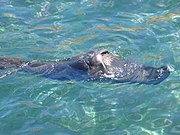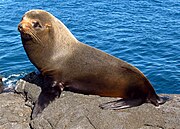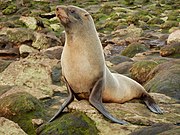Arctocephalus
| Arctocephalus | |||
|---|---|---|---|
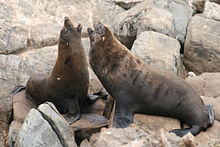
| |||
New Zealand fur seal
| |||
| Scientific classification | |||
| Domain: | Eukaryota | ||
| Kingdom: | Animalia | ||
| Phylum: | Chordata | ||
| Class: | Mammalia | ||
| Order: | Carnivora | ||
| Clade: | Pinnipedia | ||
| Family: | Otariidae | ||
| Subfamily: | Arctocephalinae | ||
| Genus: | Arctocephalus É. Geoffroy Saint-Hilaire & F. Cuvier in F. Cuvier, 1826 | ||
| Type species | |||
| Species | |||
|
| |||
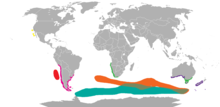
| |||
| |||
| Synonyms | |||
| |||
The genus Arctocephalus consists of the southern
Taxonomy
The number of species within the genus has been questioned, primarily based on limited molecular data. The issue is complicated because some of the species are able to produce fertile hybrids. A recent review recommended the retention of seven species, deprecating the New Zealand fur seals to a subspecies of the South American fur seal, while also questioning the status of the Guadalupe fur seal.[2] Other recent studies have indicated the genus may be paraphyletic, and some taxonomic reshuffling was previously done to account for this; however, more recent studies support it being monophyletic, with the alleged paraphyly being a consequence of incomplete lineage sorting.[3][4]
Extant Species
| Common name | Scientific name and subspecies | Range | Size and ecology | IUCN status and estimated population |
|---|---|---|---|---|
| Antarctic fur seal | Arctocephalus gazella , 1875)
(Peters |
Subantarctic islands
|
Size: Male: 180 cm (71 in) long; 130–200 kg (287–441 lb) Female: 120–140 cm (47–55 in) long; 22–50 kg (49–110 lb)[5] Habitat: Neritic marine, oceanic marine, intertidal marine, and coastal marine[5] Diet: Krill, cephalopods, fish, and penguins[5] |
LC
|
| Guadalupe fur seal | Arctocephalus townsendi , 1897)
(Merriam |

|
Size: Habitat: Diet: |
LC
|
| Juan Fernández fur seal | Arctocephalus philippii , 1866)
(Peters |

|
Size: Habitat: Diet: |
LC
|
| Galápagos fur seal | Arctocephalus galapagoensis (Heller, 1904) |
Galápagos Islands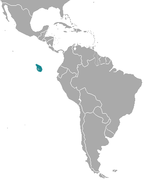
|
Size: Male: 150–160 cm (59–63 in) long; 60–68 kg (132–150 lb) Female: 110–130 cm (43–51 in) long; 27–33 kg (60–73 lb)[6] Habitat: Neritic marine, oceanic marine, intertidal marine, and coastal marine Diet: Small squids and a variety of fish |
EN
|
| Brown fur seal or Cape fur seal | Arctocephalus pusillus , 1775)
(Schreber Three subspecies
|
Southern African and Australian coasts (dark blue indicates breeding grounds)
|
Size: Male: 201–227 cm (79–89 in) long; 218–360 kg (481–794 lb) Female: 136–171 cm (54–67 in) long; 41–113 kg (90–249 lb)[7] Habitat: Neritic marine, oceanic marine, intertidal marine, and coastal marine Diet: A wide variety of fish, cephalopods, and crustaceans, and sometimes African penguins and other seabirds |
LC
|
| New Zealand fur seal | Arctocephalus forsteri (Lesson, 1828) |

|
Size: Habitat: Diet: |
LC
|
| Subantarctic fur seal | Arctocephalus tropicalis , 1872)
(Gray |

|
Size: Habitat: Diet: |
LC
|
| South American fur seal | Zimmermann , 1783)
|

|
Size: Habitat: Diet: |
LC
|



